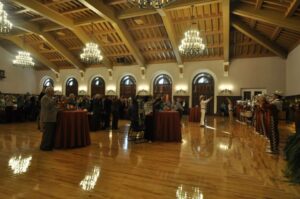Making History
 One of the best ways to understand an organization is to learn its history. As Peter Senge puts it, “Today’s problems are the result of yesterday’s solutions.” That seems to me a straightforward way to remind us that an organization didn’t simply appear when we joined it. It has a full history of good ideas as well as wild mistakes that all occurred without us. I suspect all of us have had the experience of working with a new colleague who doesn’t see the importance in learning why we do things the way we do. Yes, sometimes the way we do things doesn’t make sense any longer, but it did at some point. Understanding that history helps with two things. It encourages us as the new person to acknowledge and respect the work that has gone before. It also gives us an understanding of why things are the way they are which helps us be more effective at changing them.
One of the best ways to understand an organization is to learn its history. As Peter Senge puts it, “Today’s problems are the result of yesterday’s solutions.” That seems to me a straightforward way to remind us that an organization didn’t simply appear when we joined it. It has a full history of good ideas as well as wild mistakes that all occurred without us. I suspect all of us have had the experience of working with a new colleague who doesn’t see the importance in learning why we do things the way we do. Yes, sometimes the way we do things doesn’t make sense any longer, but it did at some point. Understanding that history helps with two things. It encourages us as the new person to acknowledge and respect the work that has gone before. It also gives us an understanding of why things are the way they are which helps us be more effective at changing them.
I’m not a historian though I took several upper division classes in history as part of my degree. I’ve always been interested in history and the histories of whatever campus I’m part of have always intrigued me. Because I pay attention to history tidbits, I know why Norman, Oklahoma and the University of Oklahoma campus are filled with trees even though they sit in the middle of the plains. (The first university president bought out a nursey in Kansas, planted trees on campus and gave trees to residents who committed to growing them. Statues on campus and a figure on the university seal of The Seed Sower memorialize this act and recognize the importance of sharing seeds of knowledge.)
One of the aspects of working in any organization, but especially one that has been around for a while is that there is always more to learn about the organization’s history and the why of things. I had been part of UT Austin as a staff member and student for a long time and didn’t know that Martin Luther King, Jr. had spent the night in the Texas Union until I was back on the UT Austin campus as VPSA in 2013. We were working to name the Union Ballroom after Dr. Shirley Bird Perry when someone shared this story.
When I joined UT Austin the first time in 1986, the name of Shirley Bird Perry was already a legend. Her list of accomplishments is too long for this essay, but here’s a link to her biography on the website of the Texas State Cemetery where she was buried in 201l.
https://cemetery.tspb.texas.gov/pub/user_form.asp?pers_id=11670
Though she later became Director of the Union, the first woman to serve as president of the Association of College Unions-International (ACUI), Vice President for Development and Governmental Relations, and then the first Vice Chancellor for Development and Governmental Relations of the UT System, her first campus job was as program director for the Texas Union.
The Texas Union itself, as one of the first student life buildings constructed on campus, has a long and storied history serving as a site for famous speakers, musicians, and actors as well as campus dances, and once upon a time, roller skating. The Cactus Café was often host to up-and-coming singers who later became nationally and internationally known. In March of 1962, while Shirley Bird, as everyone referred to her, was program director, the Union hosted Martin Luther King, Jr.
UT Austin had begun admitting Black students in the 1950s, but there was still a long way to go in fact and in law both on campus and in the surrounding community of Austin. Thus, when Dr. King accepted the invitation to speak at UT that spring, he was not able to stay in one of the nearby hotels. So, Shirley Bird Perry refurbished a small room on the third floor of the Texas Union. It was already lightly furnished as a bedroom but as the story goes, Shirley Bird brought linens and a small lamp from her home for the bedside table. Because of her, Dr. King had a safe and comfortable place to sleep and gave his speech in the Union Ballroom as planned.
UT Austin’s history with regard to race relations is as poor and uneven as any campus that was part of the Confederacy. That history is visible in the architecture and until recently in the statues on campus. But as is true everywhere, there were always people on campus and in the community who were working against that story, to create a new story, to make history. Some of their stories are well known. Some like Dr. Perry’s are less well known. But each person’s work to make a difference for one person or a group of people matters as we continue to work to live up to Dr. King’s words and dreams.
As we remember Dr. King this week, we continue to be challenged to live up to the true meaning of the ideals he espoused. I suspect on every campus, and in any organization, there are stories like this one that make up part of the history of change. It’s up to each of us to learn about our history, good and bad, and to share those stories. It’s up to each of us to do the work of change, whether or not anyone remembers us in the future, because the actions of each one of us create the current culture and thus the foundation for future work. Understanding our own history makes it possible to honor that history, and to build on it or work to change it as needed.
What are you doing to make history today?
Take care (and stay warm!)
Gage
PS If you’re curious, here’s a timeline about integration at UT Austin. https://community.utexas.edu/integration/timeline/#:~:text=August%202%2C%201962,including%20dormitories%20and%20intercollegiate%20athletics.
Links about UTAustin statues
https://www.texastribune.org/2015/08/30/ut-austin-removes-confederate-statue/
https://www.texastribune.org/2017/08/20/ut-austin-removing-confederate-statues-middle-night/
Picture above is the Parry Ballroom in the Texas Union on dedication day.
